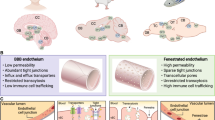Summary
Adult albino rats were injected intraperitoneally with oxine and alloxan in doses ranging from 100 to 400 mg per kg body weight. Two minutes to several hours following injection the animals were killed by vascular perfusion with buffered sodium sulfide and the brains immediately removed and frozen. Cryostat sections were prepared and stained according to Timm's procedure. A few animals were injected intracerebrally. In contrast to earlier reports by others it was found, under appropriate conditions, that oxine markedly reduced the staining of most parts of the neuropil of the forebrain while alloxan had no effect on the sulfide silver picture at all.
Similar content being viewed by others
References
Albert, A.: Selective toxiocity and related topics, 4. ed. London: Methuen & Co. Ltd. 1968.
Albert, A., Rees, C., Tomlinson, J.: The influence of chemical constitution on antibacterial activity. Part VIII. 2-mercaptopyridine-N-oxide, and some general observations on metal-binding agents. Brit. J. exp. Path. 37, 500–511 (1956).
Albert, A., Rubbo, S., Goldacre, R., Balfour, B.: A study of 8-hydroxyquinoline and related compounds. Brit. J. exp. Path. 28, 69–87 (1947).
Danscher, G.: An instrument for immobilization of small experimental animals. Z. Versuchstierk. 14, 69–71 (1972).
Danscher, G., Haug, F.-M. Š., Fredens, K.: Effect of diethyldithiocarbamate (DEDTC) on sulfide silver stained synapses. Reversible blocking of Timm's sulfide silver stain for “heavy” metals in DEDTC treated rats. (Light microscopy.) In preparation.
Denigès, M. G.: Quoted by Schranz, W.: Allgemeine analytische Methoden, analytische Operationen, Apparate und Reagentien. Z. anal. Chem. 42, 180–181 (1903).
Elderfield, R. C.: Heterocyclic compounds, p. 309–312. New York: John Wiley & Son 1957.
Euler, C. von: On the significance of the high zinc content in the hippocampal formation. In Passouant: Physiologie de l'hippocampe, p. 135–145. Paris: Editions du Centre National de la Recherche Scientifique 1962.
Green, A. L.: The inhibition of dopamine-β-oxidase by chelating agents. Biochim. biophys. Acta (Amst.) 81, 394–397 (1964).
Haug, F.-M. Š.: Selective staining of central nervous structures with Timm's sulfide silver method for heavy metals. A light microscope study in the rat. (In preparation 1972a.)
Haug, F.-M. Š., Danscher, G.: Effect of intravital dithizone treatment on the Timm sulfide silver pattern of rat brain. Histochemie 27, 290–299 (1971).
Hu, K. H., Friede, R. L.: Topographic determination of zinc in human brain by atomic absorption spectrophotometry. J. Neurochem. 15, 677–685 (1968).
Kadota, J.: Studies on experimental diabetes mellitus as produced by organic reagents; oxine diabetes and dithizone diabetes. J. Lab. clin. Med. 35, 568–591 (1950).
Maske, H.: Über den topochemischen Nachweis von Zinc im Ammonshorn verschiedener Säugetiere. Naturwissenschaften 42, 424 (1955).
Ørskov, H., Olsen, T. S., Nielsen, K., Rafaelsen, O. S., Lundbaek, K.: Kidney lesions in rats with severe long-term alloxan diabetes. I. Influence of age, alloxan damage, and insulin administration. Diabetologia 1, 172–179 (1965).
Otsuka, N., Ibata, Y.: Über die Veränderungen des Zinkgehaltes in der Hippocampusformation der Ratte nach Dithizon-, Alloxan- und Oxinzufuhr. Histochemie 12, 357–362 (1968).
Patterson, J. W., Lazarow, A., Levey, S.: Alloxan and dialuric acid. Their stabilities and ultraviolet absorption spectra. J. biol. Chem. 177, 187–196 (1949).
Rubbo, S., Albert, A., Gibson, M.: The influence of chemical constitution on antibacterial activity. Part V: The antibacterial action of 8-hydroxyquinoline (oxine). Brit. J. exp. Path. 31, 425–441 (1950).
Timm, F.: Zur Histochemie der Schwermetalle. Das Sulfid-Silberverfahren. Dtsch. Z. ges. gerichtl. Med. 46, 706–711 (1958a).
Timm, F.: Zur Histochemie des Zinks. Dtsch. Z. ges. gerichtl. Med. 47, 428–431 (1958b).
Timm, F.: Zur Histochemie des Ammonshorngebietes. Z. Zellforsch. 46, 548–555 (1959).
Voigt, G. E.: Untersuchungen mit der Sulfidsilbermethode an menschlichen und tierischen Bauchspeicheldrüsen (unter besonderer Berücksichtigung des Diabetes Mellitus und experimenteller Metallvergiftungen. Virchows Arch. path. Anat. 332, 295–323 (1959).
Author information
Authors and Affiliations
Rights and permissions
About this article
Cite this article
Danscher, G., Fredens, K. The effect of oxine and alloxan on the sulfide silver stainability of the rat brain. Histochemie 30, 307–314 (1972). https://doi.org/10.1007/BF00279779
Received:
Issue Date:
DOI: https://doi.org/10.1007/BF00279779




